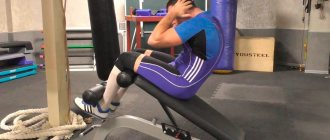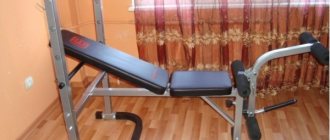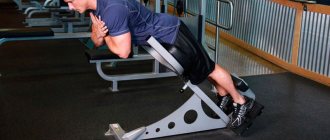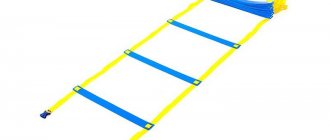Not everyone who wants to play sports has enough time to visit the gym, and home workouts require certain equipment, the cost of which is quite high. The most popular are dumbbells. They are involved in almost all exercises. And if you don’t plan to purchase sports equipment in the near future, you shouldn’t give up exercising. You can make dumbbells with your own hands from fairly cheap materials. To do this, just read the instructions on how and what they are made from.
DIY sports equipment: basic rules
You can make almost any sports equipment yourself, from simple weights to sports complexes.
The most common strength exercises can be performed at home with dumbbells.
The best, of course, are metal dumbbells, but they are much more difficult to manufacture than other designs. It is necessary not only to make the disks, but to choose the correct width of the pancakes, and to make the locking locks in a quality manner according to the calculations. You can make several heavy and several small pancakes.
The diameter of the bar (handle) must be within 3 cm; this condition must be taken into account when manufacturing dumbbells and barbells. Weights allow you to perform exercises of varying loads.
Before you start practicing at home, carefully check your equipment for the integrity of both collapsible and permanent products.
General recommendations
Before making dumbbells with your own hands, it is advisable to understand what this homemade equipment is and what specific workouts it will be intended for. Alternatively, you can use any objects that are comfortable to hold in your hands. However, they must have sufficient weight depending on the physical fitness of the athlete. You can make both small and large dumbbells with your own hands.
To ensure the maximum ratio between the effort applied and the result obtained, the weight of the dumbbells should be taken into account. For example, for beginners, homemade devices up to 2–3 kg may be essential, but for a systematic athlete, even five-kilogram options are unlikely to be useful. It is not possible to indicate the exact weight for each trainee, since complexion, age and other physiological factors play a huge role here. But there is one condition that you should focus on when making your own choice. A suitable weight is one with which it is already difficult to perform the exercises, but you still have the strength to do 2-3 repetitions.
You can achieve the desired weight of dumbbells using measuring instruments. To do this, the required amount of filler is weighed in advance, which is then poured into prepared containers.
With regular exercise, sports performance constantly changes, so you will have to monitor the number of approaches and repetitions. When certain results are achieved, it is worth thinking about increasing the weight of the equipment by 5 or 10%. Do-it-yourself dumbbells at home will help not only transform your body, but also build muscle mass. The basic set of exercises includes the following types of strength loads:
- standing or lying dumbbell press;
- squats;
- bicep curls;
- triceps extensions;
- dumbbell raises;
- lunges with dumbbells.
Before training, it is necessary to check the equipment for the integrity of all connections, as well as for its serviceability and absence of external damage.
What can be used from improvised means
People often stop playing sports due to lack of sports equipment. There is always a way out: any projectile can be replaced with a heavy object that is at hand. Some physical exercises do not require special equipment.
The most common equipment is an ordinary plastic bottle, from which I make dumbbells. To weigh them down, various fillers are used: water, crushed stone, sand, cement, small metal parts, etc.
Progression using blocks
Increase the load every 5-6 weeks, working in weekly blocks with different loads and alternating them in the style of the familiar cycle of accumulation and load intensification phases. In the first block, work volumetrically, in the second, increase the working weights. What might this look like in practice?
From the first to the fourth week - 20 kg 3x12, twice a week
Weeks 5-6 – 25 kg 4x9, twice a week
Weeks 7-11 – 25 kg 3x12, twice a week
Weeks 12-13 – 30 kg 4x9, twice a week
Once again, we get a fairly effective progression scheme that will suit both intermediate trainees and experienced athletes. Again, with microslabs you can make this pattern even smoother, getting all the benefits of a linear progression when using dumbbells.
Making dumbbells with your own hands
At home, you can make both small and large dumbbells.
The first step in manufacturing is to decide what they will be made of.
From plastic bottles
To make plastic dumbbells from plastic bottles, you will need the following materials:
- bottles (2 pcs. of the same volume);
- handle 30-40 cm long (wooden stick or metal rod);
- scotch tape (insulating tape);
- filler (sand, crushed stone, small metal parts).
After all the material has been prepared, you must:
- take bottles and fill them with filler;
- wrap the handle with electrical tape in the middle (10-15 cm);
- insert one end of the handle into the neck of the first bottle until there is no movement;
- to prevent the filler from seeping through, coat the joint of the handle with silicone or glue;
- connect the second bottle to the handle, then process the joint;
- wrap the assembled structure around the handle, strengthening the connection.
From cement
Heavier dumbbells are made using a cement base. The disadvantage of concrete dumbbells is that it is difficult to evenly adjust the weight of the weighted plates, and this design is not dismountable. If a different weight is required for sports, a new apparatus will need to be made.
In order to make dumbbells at home, you will need the following materials:
- metal pipe (neck);
- cement mortar;
- bolts, screws;
- form for casting pancakes.
Then you need to:
- At the ends of the neck, make four holes evenly for 4 bolts around the perimeter.
- Install bolts into the holes, which are holding elements for the pancakes.
- Place the bar in a vertical position in the casting mold. Pour in cement mortar and leave in this position until the mortar is completely dry.
- For the second side, repeat the previous step.
You can eliminate the flowability of cement dumbbells by adding PVA glue or paint to the solution, and to increase the weight - crushed stone, gravel or small metal products.
Metal
Shells made of metal are considered the most reliable and practical.
To make dumbbells you need:
- Prepare a metal rod with a diameter of 3 cm (bar).
- Take a thin-walled pipe 15 cm long. The internal diameter should be slightly larger than the diameter of the neck.
- Place the pipe on the bar, then fix it in the middle.
- Make the required number of weight discs. This will require sheet steel.
- Use rings or a 2-3 cm long pipe as locking locks. Drill a hole in them and cut a thread for screwing in a screw. As a result, the screw that is screwed in will hold the plates by pressing them against the bar.
Pay special attention to high-quality pressing of the screw to avoid play. Collapsible metal dumbbells allow you to adjust the weight. It is also possible to make non-separable dumbbells, for this purpose welding is used as locking locks.
Manufacturing of weights
Making weights at home is also quite possible. Two options are described below.
Option one
This method will allow you to make hand or foot weights for women. You need to prepare:
- durable plastic bags or balloons;
- a pair of well-stretching unnecessary, but not torn socks (for example, not having a pair);
- sand or plasticine;
- needle and thread.
Instructions:
- First you need to form the internal parts of the weights. To do this, fill strong bags or balls with sand, tie them and form a kind of sausage. You can make one long “filling” for each weight, or two short ones.
- Place the inner part in the sock, cut off the excess parts and sew the edges.
- The weighting material is ready: due to the elasticity of the material from which the sock is made, it will stretch well and be easily put on a hand or even a woman’s leg.
Option two
Leg weights can be made from old jeans. You will need:
- old and unnecessary jeans, preferably stretchy and with good stretch;
- resealable packaging bags or ordinary plastic, but dense bags;
- sand;
- scissors;
- needle and thread.
Process description:
- Fill the bags with sand and tie them well. You should get some kind of elongated and not very voluminous pads of the same size.
- Measure the length of the bags to determine the size of the weight case. Multiply the resulting figure by two, add two or three centimeters to it for allowances.
- Measure on the legs of your jeans the number obtained as a result of the calculations described in the previous paragraph. Cut off the pieces.
- Fold the cut pieces of the legs in half and place the bags in them. Sew the edges of the denim cover, or better yet, sew it on a machine for reliability.
- To separate individual weights, you can make one line between them. Also at this stage, you can distribute the bags so that the devices are convenient to put on and use. For example, you can leave free spaces between them.
Some tips:
- Adequate weight should be used to ensure a suitable load without overexerting yourself. To do this, take measurements during the manufacture of the projectile to achieve the ideal mass.
- Choose exclusively durable and reliable materials, since the quality of the equipment directly affects safety during training.
- Take care to secure all elements of the sports equipment so that during exercise they do not accidentally fall off and injure you.
Now you can make weights and a barbell with your own hands and avoid the cost of sports equipment.
How to make a barbell from improvised materials
You can make a barbell using available materials. Its design is practically no different in complexity from a dumbbell.
The main element is the bar; without it it is impossible to make a barbell. There are many options to make a barbell at home.
Plastic bottles
The design of a homemade barbell is identical to a dumbbell, and you can use bottles of water or other material for weighting. But for more serious weight loads, pancakes are made not from two bottles, but from 8 (4 on each side). The bottles are filled with filler, then 4 pieces are tightly fastened together, forming a square. After which the bar is installed in the space between the bottles and secured.
Wheels
Another easy way to make a barbell is to use car wheels as weights. As a rule, assembled wheels are used. This type of sports equipment allows you to throw the barbell onto the floor after performing an exercise, without fear of damaging both the barbell itself and the floor.
For such a rod, a plate with bolts is installed at the end in accordance with the bolt pattern of the disk.
Concrete pancakes
To make pancakes from concrete, you must first make a mold for pouring the solution. Place a cylindrical object in the center of the mold. The diameter of the cylinder should be slightly larger than the diameter of the neck. Then the cement mortar is diluted, which is poured into the mold until completely dry.
In order to make the rod more stable, it is necessary to install metal sheets (inserts) when pouring. All concrete weights for barbells must be made in pairs and have the same weight.
The bar must have a locking element that will prevent the plates from moving to the center. Additionally, locking locks must be made.
Microtiles on magnets
If you love non-standard solutions, then this is the solution for you! Order yourself a set of microtiles of any weight, from 250 to 500 grams, and attach them to dumbbells. You will receive a micro-increase in working weight and will be able to progress at least every week by changing micro-weights.
Example
First week - 20 kg
Second week - 20.5 kg
Third week - 21 kg
Fourth week - 21.5 kg
Fifth week - 22 kg
Two kilograms in five weeks is a really smooth increase, while the standard step for dumbbells used in the gym is usually at least two kilograms per week. When using microtiles, you solve this problem completely.
Instructions for assembling a homemade rod
The bar is the most important part, thanks to which the barbell is able to withstand heavy weight loads. The safety of performing exercises depends on the quality of the bar.
When making the neck, it is necessary to use durable materials. In order to make a fingerboard, you will need steel reinforcement, an iron pipe or a crowbar. When choosing a material, pay attention to the thickness, as it should be comfortable for a clenched palm.
The entire process of making a barbell at home can be seen in the video
Cans
Beginners can also make dumbbells using ordinary cans. The action is performed in stages:
- All jars should be selected not only in an even number, but also of the same size;
- Before work, the entire upper part is cut off;
- Next, it is important to prepare either an equal-sized stick or a pipe. If the handle is wooden, then it is better to take care in advance that it is intact so as not to damage the palm. The size of pipes or sticks is 25 cm, diameter is 3-4 cm;
- It is better to paint metal pipes by sanding them first;
- The prepared cement should be poured into jars;
- The pipe is placed in the middle, while at the ends that are immersed inside, it is better to screw self-tapping screws to avoid it slipping out during use;
- Hold it in one position for some time. Only after waiting for the solution to thicken can the pipe be released;
- It is better to leave the resulting dumbbells alone for a day so that the solution completely hardens.
The weight of such sports equipment will not be too large, but you should not increase it with fittings. They are ideal for beginner lessons.
Wooden pancakes
First of all, you need to get two solid wooden circles from the sawmill or make them yourself, the thickness of which is at least 10 cm. You can select the diameter yourself, based on which “pancake” is more convenient for you to lift. Naturally, these elements should be the same in weight and shape. Using a drill, make a hole in the middle of the circle for the neck.
How to make a barbell with your own hands next? And now your task is to use a hammer to hammer into these “pancakes” as many metal objects as possible - iron debris, old nails, staples. It’s a good idea to purchase slate nails specifically for homemade projects. The main thing is that the weight of the “pancakes” is uniform.
It may not be necessary to hammer in all the hardware you find. Make your plates heavier as your workouts require more and more heavy loads.
Concrete "pancakes"
The load will be more serious and monolithic, but its production will take more time. The barbell is made with your own hands like this:
- First of all, we make a form for concrete pouring from plastic material - according to the outlines of a regular “pancake”. Don't forget to install a cylinder in the middle that is equal in diameter to the bar you are using.
- It’s a good idea to stock up on various iron inserts to make the structure more durable. Place some of them at the bottom of the form, add some as the concrete is poured.
- Wait for the material to set.
- Using the outlines of the first concrete pancake, make a mold for the second. For sports exercises to be effective, they both must be equal in weight.
Mixing concrete
To prepare concrete, you will need 4 ingredients:
- Cement.
- Sand.
- Crushed stone.
- Water.
In an iron basin or any other container suitable for these purposes, it is necessary to mix crushed stone, sand and cement in equal proportions with the gradual addition of water and mixing until smooth. The solution should be thick enough so that the handles can be fixed in it later.
Brick "pancakes"
The advantage of such homemade “pancakes” is that the weight of the bricks is not heavy even for a novice athlete. Therefore, you can use several of these weights at once, increasing the load on the muscles.
In order to make a barbell with your own hands using this method, you need to spend a little more time and have the skills to work with an angle grinder. Here's what we'll need:
- Ten bricks.
- Grinder and a circle for her on stone.
- Stone drill.
“Cooking pancakes” is simple here:
- In the middle of each brick, make a hole with a drill, slightly larger in diameter than the neck.
- Use a grinder to shape each brick into a circle.
- Weigh your pancakes. You can further adjust them one by one weight or sign each weight with a marker.











